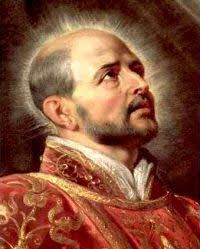
St Ignatius of Loyola was born in the ancestral castle of the Loyolas in the Basque province of Guipúzcoa, Spain, in 1491. The youngest son of a noble and wealthy family, Ignatius became a page in the service of a relative, Juan Velázquez de Cuéllar, treasurer of the kingdom of Castile in 1506. In 1517 Ignatius passed as a knight into the service of another relative, Antonio Manrique de Lara, duke of Nájera and viceroy of Navarre, who employed him in military undertakings and on a diplomatic mission. While defending the citadel of Pamplona against the French, in May 1521. Ignatius was hit by a cannonball, sustaining a bad fracture of his right leg and damage to his left. This event closed the first period of his life.
The period of reorientation is the second period of Ignatius’ life, in which he turned toward a saintly life. After the treatment at Pamplona, he was shifted to Loyola in June 1521. There his condition was serious and underwent painful surgeries. During the period, he read the life of Christ and a book on the lives of the saints. The version of the lives of the saints contained prologues to the various lives by a Cistercian monk who conceived the service of God as a holy chivalry. This view of the life profoundly moved and attracted Ignatius. In February 1522, Ignatius bade farewell to his family and went to Montserrat, a place of pilgrimage in the north-eastern Spain. He spent three days in confessing the sins of his whole life, hung his sword and dagger near the statue of the Virgin Mary as symbols of his abandoned ambitions and went to Manresa at Barcelona. The sojourn at Manresa was marked by spiritual trials as well as joy and interior light. There he sketched the fundamentals of his little book The Spiritual Exercises which was approved by the then Pope Paul III in 1548. This book is a manual of spiritual arms containing a vital ad dynamic system of spirituality. This is the end of the second period of his life.
In March 1523, Ignatius left Barcelona and went for a pilgrimage to Jerusalem. He wanted to settle in Jerusalem but the Franciscan custodians of the shrines of the Latin Church did not listen to his plan. He left Jerusalem and reached Barcelona in March 1524. There he studied Latin for nearly two years. In 1526, he was transferred to Alcala. There he formed a little group as his followers. Due to this, he was found to be suspicious and imprisoned along with his followers. When he was found innocent and released, he left Alcala and reached Paris on February 2, 1528 and remained as a student until 1535. During his stay there, he won the coveted M.A. of the famous university of Paris.
In 1537, Ignatius along with his companions wanted to make a pilgrimage to Jerusalem but war between Venice and Turkish Empire rendered this impossible. During this period, Ignatius had one of the decisive experiences of his life. At a roadside Chapel of La Storta, he saw a vision of Christ with a cross on his shoulder and beside him the Eternal Father, who said, “I wish you to take this man for your servant” and Jesus took him and said, “My will is that you should serve us”. On Christmas day of 1538, he said his first Mass at the Church of St Mary Major in Rome. This is the end of the third period of his life.
The final period of Loyola’s life was spent in Rome or its vicinity. In 1539, The companions decided to form a permanent union named ‘Society of Jesus’, adding a vow of obedience to the Roman Pontiff to the vows of poverty, chastity and obedience that they had already taken. In 1540, Pope Paul III approved the plan of the new order ‘Society of Jesus’ and Ignatius Loyola was the choice of his companions for the office of General.
The Society of Jesus developed rapidly under Ignatius’ guidance. When he died in 1556, there were already about 1,000 Jesuits divided into 12 administrative units, called provinces. Three of these were in Italy, a like number in Spain, two in Germany, one in France, one in Portugal and two overseas in India and Brazil. Ignatius in his last years was occupied with Germany and India, to which he sent his famous followers Peter Canisius and Francis Xavier respectively. He also dispatched missionaries to the Congo and to Ethiopia. In 1546, Ignatius secretly received into the Society Francis Borgia, duke of Gandía and viceroy of Catalonia. When knowledge of this became public four years later it created a sensation. Borgia organized the Spanish provinces of the order and became third general.
Ignatius Loyola left his mark on Rome. He founded the Roman College, embryo of the Gregorian University, and the Germanicum, a seminary for German candidates for the priesthood. He also established a home for fallen women and one for converted Jews. He and his work were much admired during his lifetime. But he also met with opposition in the church, outside it by the Protestant leaders and even from some of the Catholics. Due to frequent illness, Ignatius Loyola resigned from the post of Superior in January 1551. But he continued to direct the Order until his death on July 31, 1556.
Ignatius Loyola was beatified by Pope Paul V in 1609 and was canonized by Pope Gregory XV in 1622 and his Feast Day is July 31. In 1922, he was declared Patron of all Spiritual Retreats by Pope Pius XI. The spirit of Ignatius of Loyola lives on in the Society of Jesus and in the Jesuit Constitutions, which still regulate the lives and aspirations of over 14,000 Jesuits, scattered through most countries of the world.